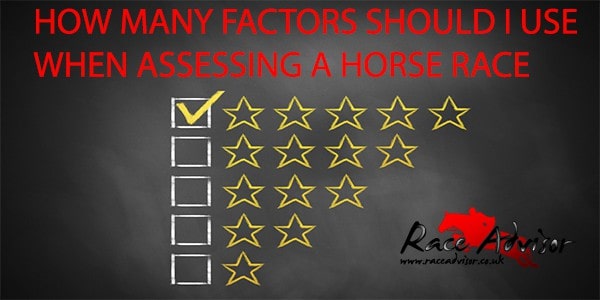How Many Factors Should I Use When Assessing A Horse Race

It’s very easy to get overloaded with information when looking at horse racing. There are loads of different ways to bet from laying, backing, dutching, trading and more.
Then are hundreds of different approaches to finding selections to bet.
Even if you decide to read form there are hundreds of different ways to do that as well.
Can there possibly be so many ways that actually work?
Absolutely. Because the key to making any of the approaches work is you.
Everything that makes you who you are is the key to which of the approaches and strategies are going to work for you.
The time you have available to find selections is different to mine. Your ability to cope with losing streaks is different to mine. Your assessment of risk is different to mine. Your preference to how you find selections is different to mine. The number of bets you want to place is different to mine.
And so it goes on.
Every single bettor is a different person, and that means the approach that will suit you is going to be different to everybody else.
You may be a form reader, the same as other people, but I can guarantee you the way you read form will be different to everybody else.
And that’s one of the reasons why on the Race Advisor we write about so many different approaches and techniques you can use. Because we know that one thing will work for you and something else will work for someone else.
However there is one truth across everybody who starts reading horse racing form…
They try to take too much information into account.
There’s a hell of a lot of information out there about every horse. And the truth is… most of it is noise.
What that means is that it’s unnecessary to take it into account when analysing a race. All it does is distract you from the information that is actual going to make an impact on the race.
So how the heck do you choose what to focus on?
The bottom line is that most of the time you can analyse every race with just four pieces of information per horse and make a long-term profit.
Those pieces of information are:
- Speed
- Preference over conditions
- Fitness
- Connections
The key to making this work is to choose one piece of information for each of those four categories that are specific to the race.
As an example for a sprint all-weather race I would use:
- (Speed) Pace (looking for fast front-runners)
- (Preference over conditions) Speed over distance of the race
- (Fitness) Come within 0.5 lengths of the winner in a similar race in last 30 days
- (Connections) Jockey with experience on horse over sprints (preferably at same track)
Above I have chosen just one piece of information for each of the categories that I would want to use to analyse an all-weather sprint.
But what about a long distance handicap hurdle?
In that situation I may use:
- (Speed) Top speed rating amongst other runners over similar distance/going/weight
- (Preference over conditions) Proof that horse has come within 2 lengths of winner recently over similar distance/going/weight
- (Fitness) Had a good race within the last 45 days and doesn’t fall regularly
- (Connections) Trainer has a strong track record of training horses for these race conditions
As you can see a different set of race conditions would mean using a completely different set of information. But… still using only four pieces of information we can get a complete overview of everything that is important in a race.
So here’s what you need to do now…
Take a minimum of one meeting every day and take the first race. Before you look at a single horse in the race write down what piece of information you’re going to use for each category.
Then go in and score each horse out of 10 (10 being best) for each of those categories using that single piece of information.
You must be ruthless and not let your eyes wander or your brain consider anything else.
And then order the horses in the race in order of strength based on those four pieces of information.
Don’t place any bets but write down the finish order.
When you have done this for every race at the meeting move on to the next day. At the end of around 20 days you should have information for 100 races.
Look and see how often you got the winner in your top three and how often you got a horse placing your top three.
Next look at which of your categories contributed the most to finding the winners.
Now repeat the process but put a little bit more emphasis on that category in your final analysis.
Do this for three or four months and you will have a custom built approach to finding winners that actually makes you a profit.